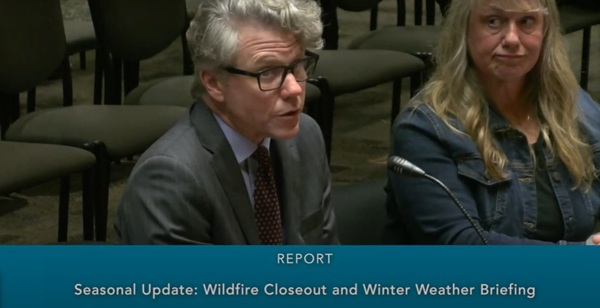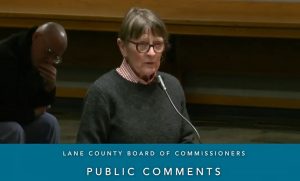With fewer shelter beds this winter, county looks to nonprofits, philanthropists, faith communities
10 min read
Presenter: Lane County expects the winter to be slightly warmer and wetter than the average, with a weather pattern known to produce ‘extreme events.‘ With commissioners Nov. 4, Emergency Manager Tiffany Brown:
Tiffany Brown (Lane County, emergency manager): We are expecting increased precipitation and increased temperatures this season. We’re expecting above-average rain and above average in terms of temperature, commonly referred to as La Niña. The ENSO (El Niño-Southern Oscillation) cycle, which is the winter weather cycle, is in a La Niña state, and it magnifies weather conditions. We’re going to see a little warmer temperatures, a little increased rain, which tends to bring snow to the Pacific Northwest.
[00:00:48] The most common way that we see this manifest itself during the winter is in the form of atmospheric rivers—large narrow channels of precipitation that result in increased rain and snowfall. The one you’re most familiar with brings precipitation from Hawaii to the Pacific Northwest—can dump as much as five inches in one day in extreme conditions.
[00:01:13] And so we do expect to see atmospheric rivers. They occur at all times, more dramatically during a La Niña.
[00:01:22] The most impact that we’re expected to see is this fall, and then just early in the year, the Weather Service predicts that we will return to a neutral ENSO state by early February. So while we may see snow and increased precipitation, it is expected to be short-lived.
[00:01:41] We’ve got some activities going on around mass care. Our Human Services Division is leaning into their partnership with St. Vincent de Paul, understanding how we prepare our unhoused and most vulnerable for winter.
[00:01:55] Presenter: Commissioner Laurie Trieger:
[00:01:57] Commissioner Laurie Trieger: On the mass care side, given our ongoing conversations about seeking to close the funding gap for shelter beds, some of the shelter beds that are at risk are our extreme weather shelter beds. Can you talk about the nexus between your work and that shortfall?
[00:02:12] Tiffany Brown: At this time of year, I fold in closely with the Severe Weather Collaborative and our Human Services Division partners just to understand where I can support and be the liaison between whatever resources might be available.
[00:02:28] Commissioner Laurie Trieger: I see Steve Adams and I don’t know if any part of our advocacy with the state is bringing in the emergency and disaster response obligations that we have to fulfill on behalf of the state and how the shortage in shelter funding beds makes it harder for us to do the work they’re asking us to do on that side.
[00:02:47] Presenter: Lane County Policy Director Stephen Adams:
[00:02:50] Stephen Adams (Lane County, policy director): Indeed, Chair, Commissioner, the emergency shelter beds and the severe weather shelter beds are a goodly portion of the beds that are on the bubble. And so we certainly know that we’ve lost 60 beds thus far in addition to about 30 FTE (full-time employees) and there’s another tranche of beds that are potentially on the bubble if we’re not able to secure additional funding.
[00:03:13] Our partners, I think, at St. Vincent de Paul’s have been thinking about how best to deploy the resources that they have, and I think they’ve been doing some scenario planning just in terms of given one set of resources, these are the kinds of, they would have one configuration of Egan (Warming Center) beds available during deployments, and given another level of resource, they could deploy more.
[00:03:34] But I think the net sum of this would be a reduction or at least if we’re not able to secure those funds, then we are going to go into cold nights without sufficient beds. And if we have a prolonged ice event, as we did two winters ago, that could be very challenging for us. And that is absolutely the worst case scenario.
[00:03:56] Presenter: Commissioner Pat Farr:
[00:03:58] Commissioner Pat Farr: We talked a little bit about the ice storm of two years ago and what would happen if we had such an event. Currently, if such an event happened with the funding as projected, we would be devastated in ways that we couldn’t even imagine at this point in time. What can we do about it?
[00:04:14] Stephen Adams: Chair, Commissioner, it’s a challenge. We need resources to be able to deploy fixed assets, shelter, we need real fixed supplies to be able to ensure that people have access to be able to get in out of the cold. And you need materials, you know, for the volunteers to work. So obviously our shelter, our cold weather shelter depends heavily on volunteers.
[00:04:36] And I think, you know, certainly lessons learned from the ice storm from a couple of years ago have already kind of rolled in thoughts around: How can we use our transportation resources to get volunteers to places? How can we better communicate with the EOCs (emergency operations centers) as they stand up? How can we ensure that we’re getting food into those things?
[00:04:56] But much of what we did on the basis of our lessons learned from two years ago was predicated on a functional set of shelter beds. And that’s the piece that’s more challenging at the moment with less beds available to us. And that we’re coping with a reduction in funds available to us at the federal level, at the state level, and it rolls right down to here. So what can we do?
[00:05:23] I think certainly local philanthropy is important—people willing to step forward and try to write checks as we’ve seen happening at Food for Lane County, as we’ve seen with the SNAP issues.
[00:05:34] But I think there’s a reality that there’s not enough local philanthropy here, maybe, to cover the gaps, but we have to do what we can. I think these are all challenges that we’re really struggling with at the staff level to think about how can we secure sufficient resources to be able to meet all of these needs.
[00:05:51] And it’s a rough time. It really and truly is.
[00:05:54] Commissioner Pat Farr: And finding locations is not going to be an easy prospect, but potentially stockpiling supplies like blankets, tarpaulins, extra socks, things like that. That may be something that we can encourage our nonprofits to do, as well as some of our private partners. So I think what you’re doing, what I’ve heard that you’re doing this week is stepping forward to enlist people outside of the regular circles of philanthropy and getting more people focused on the work ahead of us. And the work has never been more challenging.
[00:06:28] Presenter: Commissioner David Loveall:
[00:06:30] Commissioner David Loveall: Might I add that we encircle our people of faith in that circle. I can think of Dan Bryant, Rabbi Ruhi (Sophia Motzkin Rubenstein), her circle of friends and cohorts. And I can also think of Steve Buss and One Hope and his 100 pastors. You know, it’s time for people of faith to step up and do as they profess, I think, is the challenge that I see as a person of faith, and I’m challenging my other people of faith, too, that this may be a chance for us to shine in this winter.
[00:06:53] Presenter: The start of winter weather is also the end of the wildfire season. With a look back, Lane County Emergency Manager Tiffany Brown:
[00:07:03] Tiffany Brown: Our 2025 wildfire season started in June, and by the time it was over, we’d burned over 33,000 acres this year. The makeup looked a lot different than last year in terms of just acreage burned, the number of fires in the season, but really the major events boiled down to about three fires, the Emigrant, which we’re familiar with the biggest, the bulk of that acreage. Foley Ridge, which occurred up the McKenzie, just towards the last part of the season, and then Sugarloaf, which was 53 acres, but it came the closest of all of our events to infringing on a community, which was Oakridge.
[00:07:45] In addition to those three fires, we had 20 more here and there, from May to as recently as October, And our Fire Defense Board Chief (Steven) Wallace, who’s also the Mohawk Marcola chief, really attributes that to the quick and responsive action of our local fire agencies that we’re able to catch things before they got bigger and really minimize our fire season and the impacts that we saw.
[00:08:12] Air quality was pretty good this year. The heat stayed relatively tolerable. And so Public Health ended up having a pretty quiet season with regard to fire season. Public Works didn’t see as much as they tend to. Search and Rescue and Dispatch are really where we saw the most action.
[00:08:34] We had a few evacuation levels, Level 3 a couple of times, all short-lived. We didn’t lose structures, we didn’t stand up shelters, but it was the folks in our Sheriff’s Office dispatching, sending out those alerts, and facilitating evacuations in those early stages.
[00:08:56] Cooperators are a big part of our ongoing hazard season, regardless of what that is. We saw cooperators on a couple of fronts. We participated in the community meetings, in the communities where the fires were happening. Activities were less, so we didn’t stand up the regular weekly cooperators call, or last summer we hosted that call sometimes three days a week.
[00:09:23] Nothing rose to the level of warranting that this year. We switched into something different that was sort of a halfway point, and that is that every Friday we sent a weekly email to the cooperators, letting them know what was going on, who was on scene, where the areas of concern were, and just any general information about air quality and links to what was going on.
[00:09:49] If something had turned in, we had our cooperators poised and paying attention every week to what we were talking about.
[00:09:57] We did have a relatively quiet season. A lot of those stakeholders that we rely on for that wildfire planning weren’t as tied up so we got a lot more done this summer than I think we expected.
[00:10:10] We implemented Genasys, our new evacuation software, this summer. We redrew all of the evacuation zones for all of Lane County, including the urban area. This fire season did give us time to utilize the Genasys system. And as you’ll recall from talking to about this before, it is an evacuation system that talks to our alert system. And so that went well.
[00:10:38] We have ongoing development around alerting and evacuation, but we’ll continue to build that system as we go into the winter.
[00:10:47] Drawdowns and dam monitoring are a common part of winter weather having to do with the fisheries and we’ll be keeping an eye on that. We’re in the course of getting ready to issue a request for proposals on a countywide debris management contract that certainly lends itself to winter weather. This contract would be one that the county enters into and that every jurisdiction in the county could piggyback on should the need arise.
[00:11:17] I talked to Public Works today. They have secured all of their contracts for winter. They’re preparing equipment and staff. And we’re just seeing staff and community organizations across the community leaning in and preparing for winter.
[00:11:35] And then finally, we’ll just be doing winter weather and monitoring. You know, you can have a 90-day outlook, a 30-day outlook, but it really comes down to the next seven or 14 days, so how we manage that, monitor that, and maintain coordination and communication with the cooperators when we see something on the forecast.
[00:11:56] One last thing. When I appeared before you in the spring, we introduced the HELP / OK sign. And Commissioner Trieger, aptly so, said, ‘Great idea, but how are you going to get them out to the public?’
[00:12:10] And so that was part of our campaign this fall. We’ve reached out to our cooperators to see who would be willing to host the signs on a public counter and put themselves on a list that we could then turn around and announce to the public. I’m delighted to say that we found 45 partners throughout the county from the coast to Creswell to Coburg. There wasn’t an area that we didn’t: libraries, post offices, public counters of local governmental agencies. And we distributed 13,000 signs across those 45 locations.
[00:12:51] And probably some didn’t get distributed, right? But I feel comfortable giving you that number because in addition to those 45 people, we had homeowners associations and nonprofits and people step forward and ask for more signs.
[00:13:04] So while there’s still maybe some sitting on counters, we distributed some more over there. Thank you for asking the question. It really got us thinking about how to make that more effective, and that’s a program that won’t go away. It’s a plate spinning now. People are familiar with it. And so I wanted to follow up and let you know.
[00:13:22] Presenter: Tiffany Brown looks back at the 2025 wildfire season in Lane County and looks ahead to winter weather. With federal and state funding cuts to emergency shelter, commissioners say nonprofits, philanthropists, and faith communities will have to do more.






